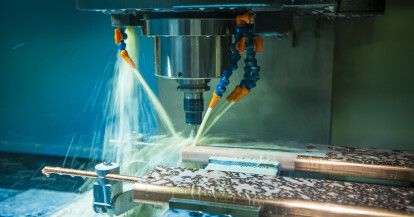Fibre laser - working principle, advantages and use

Laser technology has revolutionised many industrial sectors, offering precise and efficient solutions for a variety of applications. Among the different types of lasers, the fibre laser, or fibre laser, occupies a special place.
How does it work, what advantages does it offer in production technologies, how can it be used and what else is worth knowing about this material cutting technique? - all of this is explained in the following article.
What is laser cutting?
Laser cutting is the process of using a concentrated laser beam to cut materials with precision. By harnessing the power of lasers, the cutting process eliminates the need for traditional methods such as knives or saws. This technology has become revolutionary in many industries due to its precision, speed and versatility.
How does a fibre laser work?
Fibre laser or fibre laser cutting technology is characterised by high efficiency and excellent beam quality. The wavelength of the laser light obtained is ten times smaller than that of a CO2 laser. This type of laser uses an optical fibre as the medium. When an electrical voltage is applied to the fibre, this leads to the emission of photons. These photons are reflected inside the fibre, gaining intensity through a process known as forced emission. Eventually, some of the light passes through a partially transparent mirror, creating a laser beam that can be directed at the workpiece. The energy of this laser beam, whether continuous or pulsed, causes the material in the cutting gap to melt, while at the same time the molten material is removed by means of a gas jet. Thus, at the appropriate power intensity, it is possible to melt copper or aluminium sheets and carry out the cutting process effectively.

Fibre laser cutting - what are the advantages?
The use of fibre laser technology offers many advantages over traditional cutting methods and other types of lasers. These include:
- High precision: fibre lasers provide extremely accurate and precise cutting, enabling intricate patterns and finishes of the highest quality. The cut edge is of the highest quality.
- Process speed: the concentrated beam of the fibre laser enables fast cutting, resulting in increased productivity and reduced production times.
- Energy efficiency: fibre lasers are known for their high energy efficiency, consuming less energy compared to other types of lasers. As a result, operating costs are reduced.
- Low maintenance costs: the robust design of the fibre lasers eliminates the need for complex maintenance procedures such as gas replacement, resulting in less downtime and increased availability in the production cycle.
What materials can be cut with a fibre laser?
Fibre lasers are excellent for cutting a wide variety of materials, such as:
- metals, e.g. copper, stainless steel, aluminium or brass. They can machine different thicknesses with high precision and speed;
- plastics, including acrylic, polycarbonate, ABS and many others. The use of the laser allows for intricate patterns and smooth edges;
- composite materials such as carbon fibres, glass fibres and laminates.

What is the difference between a fibre laser and a CO2 laser?
While both types of lasers - fibre and CO2 - are very widely used in industry, they differ in several respects. These include:
- wavelength: fibre lasers operate in the near-infrared range (typically around 1 μm), while CO2 lasers emit light in the mid-infrared range (around 10 μm). The shorter wavelength of fibre lasers allows for better absorption by metals, resulting in more efficient cutting.
- maintenance - fibre lasers have a robust design, eliminating the need for gas changes or other complex maintenance procedures associated with CO2 lasers,
- energy consumption - the fibre laser cutting process is much more energy efficient than the CO2 laser cutting process. Significantly less energy is then used, with the same output.
- cutting speed - fibre lasers typically offer faster cutting speeds compared to CO2 lasers, resulting in higher productivity.
Application of fibre lasers
The versatility of fibre lasers means that they are used in many industries. These include:
- automotive sector: fibre lasers are used for precision cutting of automotive components such as chassis parts, body sheets or exhaust systems. The speed and precision of this technology, enable efficient production in this dynamic industry;
- Aerospace industry: precision and reliability are key here. Lasers are used to cut complex shapes in materials such as titanium, aluminium and composites, providing lightweight and high-performance aerospace components;
- electronics industry: its ability to process delicate materials and its high cutting precision make the fibre laser the ideal tool for this industry. Components such as printed circuit boards, connectors and sensors are prepared with it;
- medical industry: in this sector, the laser is used to cut surgical instruments, stents, implants and other medical components;
- jewellery industry: fibre lasers have also transformed the jewellery manufacturing process, enabling precise cutting of metals and precious stones. They guarantee a high quality finish and allow personalisation;
- the architectural industry is also benefiting from these technological possibilities. Fibre lasers are used in architectural metalwork, enabling the precise cutting and shaping of metal components used in building facades, interior designs and art installations.
Among the many technologies our company has on offer - at Electris we also offer a sheet metal punching process using fibre lasers.
Our laser cutting line is fully automated and operated using advanced software. Thanks to the use of this technology, we are able to guarantee full repeatability of the process of cutting elements from copper, aluminium or stainless steel sheets.

Summary
The fibre laser, also known as the fibre laser, has become a groundbreaking tool in laser technology, offering exceptional precision, high cutting speed, energy efficiency and versatility. With the ability to cut a wide variety of materials and applications in industries such as automotive, aerospace, electronics, medical, jewellery and architecture, fibre lasers have become an indispensable tool for manufacturers and designers.



